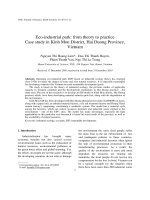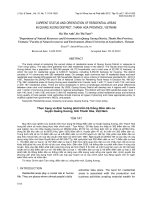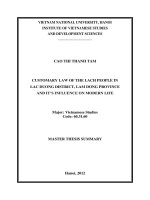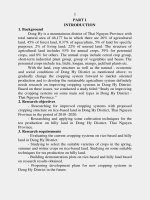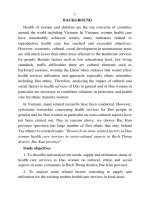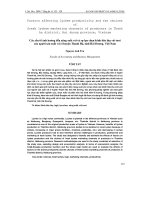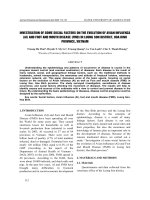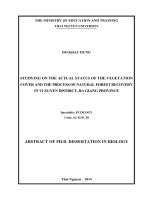Initial research on protestantism in La Hủ people in Mưong Te district, Lai Chau province, Vietnam
Bạn đang xem bản rút gọn của tài liệu. Xem và tải ngay bản đầy đủ của tài liệu tại đây (706.43 KB, 9 trang )
Religious Studies. N0.01 & 02 - 2015
80
PHÙNG THỊ DỰ *
INITIAL RESEARCH ON PROTESTANTISM IN LA HỦ
PEOPLE IN MƯỜNG TÈ DISTRICT, LAI CHÂU PROVINCE,
VIETNAM
Abstract: Before the year 1987, the ethnic minorities in Lai Châu
had practiced traditional religions. In the past twenty years,
Protestantism penetrated into the communities of Hmong, Dao,
Thai and other ethnic minorities then it expanded greatly in Lai
Châu province. In this context, a part of La Hủ people in the
border villages in Mường Tè district also converted to
Protestantism (it is called Xè A in La Hủ language). Although the
process of evangelization was intermittent and the number of
believers was not crowded, but this religion has had a certain
impact on the lives of La Hủ people. Basing on actual survey data,
this article initially study the process of spreading Protestantism to
La Hủ people in Mường Tè district, Lai Châu province and it also
suggested some solutions to this issue.
Keywords: Protestantism, La Hủ people, Xè A, Mường Tè, Lai
Châu, Vietnam.
1. Introduction La Hủ people
La Hủ people in Vietnam have originated from Yunnan province,
China. They immigrated into Vietnam approximately 4 or 5 generations1.
According to the result of the Census of Population and Housing in
Vietnam in 2009, the population of La Hủ people was 9,651 inhabitants
and it ranked the 39th among 54 ethnic groups in Vietnam2. As reported
by the Committee Propaganda Department of Lai Châu, La Hủ people
have 2,004 households, 10,141 inhabitants, 2,62% of the overall
population in this province3. La Hủ people in this area are divided into
three groups such as La Hủ Trắng, La Hủ Vàng, La Hủ Đen. They live in
42 villages in the high mountains4.
*
MA., Institute for Borderguard Studies, Vietnam.
̣ . Initial Resarch on Protestantism...
Phù ng Thị Dư
81
At present, La Hủ and Mảng, Cống, Cờ Lao people have the most
difficult lives in Lai Châu province. Generally, the spiritual life of La Hủ
is animism. “It is different from La Hủ in China, La Hủ in Vietnam is not
affected by large religions. Before the liberation of the North, their
religion and belief is primitive forms, but they are fairly complex” 5. La
Hủ people mostly worship traditional religion (except for the group
converted to Protestantism).
The soul is “la” in La Hủ language; “la” exists only in creatures like
plants, animals and human beings. A humankind has 12 souls in which
there is one principal soul determines the life and the others are subsidiary
souls. Thus, La Hủ people always protect the souls, especially children.
They conceive that when someone is sick, it means his souls are going out,
so his family has to worship to call these souls come back. “La Hủ people
think that souls exist only in creatures like plants, animals and humanbeing
but ghosts exist everywhere. The ghost is called “Xơ pẹ” or “Nê” in La Hủ
language and they are divided into types as good ghost and bad ghost”6.
La Hủ people think that humankind’s disease relates to ghosts.
Therefore, when someone is sick, he is treated by traditional medicine
and he simultaneously is treated by rites. A mystery-man’s work includes
divination, expelling ghost, calling the soul to heal, pray safety for family
members and villagers, etc. In addition, La Hủ people conceive that there
is a Buddha (kha xi củ mừ), a Rsi-immortal (gừ gia mi) and bad or luck
days. Along with this conception, there are rites such as the cult of
ancestor (dế mà khừ), eating new rice (ổ xớ cha) which are practiced in
family and the cult of village’s divine (gạ ma te).
Generally, La Hủ’s religion is a primitive form with belief in a
supernatural power that leads to fortune telling, treating by rite of
Shamanism and many other rites. These are suitable conditions for
external religions penetrate and expand.
2. The process of Protestantism’s evangelization in La Hủ
residential area
As reported by local officers, Protestantism (A Xè in La Hủ language)
is religion that a part of La Hủ people believe in. Protestantism is also
called Vàng Trứ in Hmong and Thìn Hùng in Dzao language.
Religious Studies. N0.01 & 02 - 2015
82
Nguyễn Khắc Đức in his research on “Protestantism’s characteristics
of ethnic minorities in the mountainous area in the North of Vietnam”
confirmed that “During one fourth century, from 1986 or 1987 to
present, there are 130,000 inhabitants of ethnic minorities converted to
Protestantism, they are Hmong, Dzao, Thái, Pà Thẻn, Cờ Lao, Tày, La
Hủ people, etc.”7. Basing on the religious practice of La Hủ such as
hanging crucifixes throughout their homes, gathering to pray,
compliance with canon law so we agree with the point of view that A
Xè is Protestantism.
A Xè was introduced in Vietnam from La Hủ in Gia Mễ commune,
Kim Bình district, Yunnan province, China. In a research of the origin of
this religious phenomenon, Đỗ Quang Hưng stated that “from 1998 to
present, 27 inhabitants of Yunnan province have illegally immigrated to
Vietnam then they have evangelized Protestantism in Hmong, Dzao, La
Hủ, and Cao Lan community in Lai Châu, Lào Cai, and Hà Giang
provinces. They have organized a reunion to propagate their faith in the
border area in order to entice more than 20 people from the Hmong, La
Hủ community come to China to study catechism and receive documents
like the Bible, cassette tapes, then come back Vietnam to evangelize”8.
The process of introducing and expansion Protestantism in La Hủ in
Mường Tè district, Lai Châu province could be divided into two periods:
From 1997 to 2006:
In 1997, taking advantage of the kinship relation from a long time ago,
some La Hủ from China crossed the frontier to propagate their religion to
villagers of Tá Bạ commune, Vietnam. In addition, they also exploited
the difficulty in economy and low level of education to entice the
villagers convert to Protestantism. For instance, if they converted they
would not need to work on their fields because they had the help of the
supernatural being to have food to eat. Every day, believers had to pray
and compliance with some bans such as no smoking opium, cigarette, no
drinking wine, no eating raw food, blood soup, etc. The missionaries
profit seasonal times as cultivate and harvest, they arrived La Hủ tents to
entice people convert to Protestantism. Most of La Hủ people are
illiterate, so forms of propagation are simple like verbal propaganda and
study the Bible through cassette tapes, radio and memory card.
According to statistics, in the end of 2004, the Ka Lăng commune had 18
̣ . Initial Resarch on Protestantism...
Phù ng Thị Dư
83
households with 75 inhabitants converted to Protestantism/ Xè A at
Nhóm Pố, Vạ Pù, Tá Bạ, and Là Si villages9. Then, this religion
gradually expanded to other villages such as Ứ Ma, Nhú Ma, Cờ Lò 1,
Cờ Lò 2 of Pa Ủ commune.
In this context, at the beginning of the year 2004, local officers and
border guards attempted to “propagandize the compliance with
provisions of the law of inhabitants in religious activities”. As a result of
this campaign, there were only 9 households with 25 inhabitants believe
in Protestantism and they practice their religion in tents in the fields.
From 2011 to present:
At this period, missionaries have continuously evangelized and
expanded Protestantism/ Xè A. At the beginning of 2011, propagation
has recurred at Tá Bạ and Pa Ủ communes. Many La Hủ families hang
the cross at their tents in the fields. Every Saturday, they prayed and
studied the Bible. In 2012, there were 23 households with 45 inhabitants
believe in this religion at Tá Bạ commune10. In 2013, there were 34
households with 193 inhabitants who believed in this religion at Pa Ủ
commune11. The believers were middle-aged men and it was different
from other ethnic minorities, believers were mostly women and elderly
people. It is explained that La Hủ women are timid and they don’t have a
social life so their lives depend on their husbands. The old people can not
work in the forests or cross over the border. As the result, only men work
in the fields and forests, in particular, they cross over the border to visit
relatives, goods exchange, learn about this religion and then they entice
their families to convert.
Especially, beside religious activities, the religious propaganda in the
La Hủ communityon the frontier has related to politics. Missionaries did
not only preach about Protestant dogma they also propagated the culture
and history of La Hủ people as they have the same origin and a long
history with La Hủ in Yunnan province. They had their own characters
and cultural characteristics but they have been lost.This work has inspired
the proud of their origin, established cognition of community with their
living space that did not depend on the separation of the border between
Vietnam and China.
In this situation, beside the projects of social and economic
development, local officers and border guards have explained the views
84
Religious Studies. N0.01 & 02 - 2015
and religious policies of the Communist Party of Vietnam and the State.
They also have launched a campaign of self-management the border
security and they have promoted the role of prestigious people in
managing the population. As a result, many inhabitants more understood
about religious policies of the Communist Party of Vietnam and the
State. They simultaneously realized the essence of religious propaganda,
so they were not pious and some of them gave up Protestantism to return
the traditional ancestor worship. At the beginning of 2014, the Protestant
activities finished in Tá Bạ commune. However, the number of believers
has gradually increased in Pa Ủ commune. At present, there are 74
households, 223 inhabitants who are believers and they mostly live in Ứ
Ma, Nhú Ma and Hà Xi-Hà Nê12.
Thus, the process of spreading Protestantism to La Hủ people in
Mường Tè district, Lai Châu province showed that this phenomenon has
occurred for many years inthe villages of Pa Ủ and Tá Bạ communes.
The evangelization and religious conversion were silently carried out in
the La Hủ community; it was not a movement like Hmong and Dzao
communities. Firstly, the conversion was spontaneous. Then, it was
caused by the relatives from the other side of the border, the number of
believers gradually rose. Believers even did not know what religion they
believe in. Their religious practice was not closely organized like in
Hmong. However, from the year 2011, the evangelization has not been
done by La Hủ from China, but La Hủ from Vietnam have come China
study catechism and receive documents like the Bible, cassette tapes then
they have returned their homes evangelize and entice people in their
community. Consequently, believers more understood about their religion
and their religious practice steadily expressed by worshiping just the
God, hanging the Cross at their tents in the fields. They simultaneously
throw away the ancestor altar, did not cult their parents. In addition, they
studied the Bible by La Hủ language through cassette tapes, radio and
memory card. At present, La Hủ people’s Protestantism, overall, is at the
initial period and it does not cause impacts or issues like Hmông and
Dzao people.
3. Causes led La Hủ people converted to Protestantism
In my opinion, there are four main reasons lead a part of La Hủ people
in Mường Tè district, Lai Châu province converted to Protestantism/ Xè A.
̣ . Initial Resarch on Protestantism...
Phù ng Thị Dư
85
Firstly, La Hủ’s residential area is isolated from the other ethnic
minorities; their villages are far from each other and they also are far
away the commune’s center, approximately, from 20 to 50 km.
Furthermore, the infrastructure is bad and transportation is difficult. The
relations are only closed in their groups (they maintain the economic and
cultural relationship with their kinship in the other side of the border) and
their communication with the other ethnic groups is limited (they merely
communicate with Hà Nhì people). In addition, La Hủ’s material life is
poor; they have a low educational level and their traditional religion is
simple. In this context, some La Hủ from China take advantage of the
kinship relation to entice La Hủ people in Mường Tè district, Lai Châu
province converted to Protestantism/ Xè A.
Secondly, the some contents of Protestantism are suitable to their
cultural characteristics, so it can attract them. Protestantism has a modern
and flexible mode of evangelization, especially, it is spread in La Hủ
language. In addition, religious practice and liturgy are simple and they
are appropriate for their poor condition of life. This religion
simultaneously meets their desire to escape from poor and famine life.
Thus, conversion to this religion, they find a mental supportand it fills a
hole in their spirituality. Besides, cannon law has some positive points
such as no drinking wine, no smoking opium, etc. It corresponds to many
desires of women and addicts’ family members. In particular,
missionaries always propagate that following this religion in order to
trace backto their ancestral history and culture.
Thirdly, the local political system could not meet the demand of its
duty in the new context. The officers’ educational level of Pa Ủ and Tá
Bạ communes is low and their professional knowledge is limited. Most of
the officers are not educated and they are almost Hà Nhì people; a few of
them are La Hủ people. Although La Hủ officers are educated and they
have a chance for communication with other ethnic groups they do not
show their abilities. In addition, there are a few number of officers in
charge of mobilizing the masses.
Fourthly, the local officers early discovered the penetration of a new
religion and its development situation. They have organized a campaign
to convince people come back their traditional religion. However, it was
a temporary solution of stabilization. Moreover, in a large area, the
86
Religious Studies. N0.01 & 02 - 2015
inhabitants live far from each other; they usually live in their tent in the
field and they have a closed relation with their relatives over the border,
so the re-evangelization may happen.
4. Some suggestions to solve the issue of conversion to
Protestantism of La Hủ people at present
The conversion from traditional religion to Protestantism has occurred
in ethnic minorities in the Northern West area. However, this is a
sensitive issue that relates to security and social economic development
in the border region. It needs to have flexible solutions which base on
empirical fact. The Directive No.01/2005/ CT-TTg on some tasks toward
Protestantism is the guidelines for local political system and officers in
religious affairs toward Protestantism. In applying these guidelines to the
practical situation in the area of La Hủ people in Mường Tè district, Lai
Châu province, the local officers in charge of the religious affairs should
have a common awareness of Protestantism in order to have an
appropriate solution. Thus, it needs to distinguish what is the difference
between the spiritual demands and the taking advantage of religion. It is
important to have the effective implementation of social and economic
development, raising the peoples intellectual in order to solve the causes
lead to Protestant expansion in La Hủ people. In addition, the local
officers should respect and facilitate for religious freedom rights
according to the law. It needs to have a campaign of preservation and
promotion the traditional culture.
In my opinion, there are some solutions to solve the problem of
converting to Protestantism of La Hủ people as follow:
Firstly, improving the efficiency of dissemination the guidelines and
policies of the Communist Party of Vietnam and the State; it is an
important work in religious affairs towards La Hủ people. Besides, it
needs to disseminate the nature of the Protestantism’s evangelization,
raising vigilance of taking advantage of religion in political aim,
preservation and promotion the traditional culture. These are the bases
of cognition and spiritual activities of people, facilitate for religious
freedom rights.
Secondly, improving the capacity of the local political system and
promoting the role of the border guards, training local officers, in
̣ . Initial Resarch on Protestantism...
Phù ng Thị Dư
87
particular, the officers are La Hủ people. It needs to have a financial aid
to La Hủ’s children who are healthy and clever to study in high schools,
colleges or vocational schools.
Thirdly, should develop the infrastructure such as transportation, the
telephone network coverage, the effective implementation of the
economic and social development programs in order to improve the
standard of living. Strengthening cultural exchanges between La Hủ and
other ethnic groups; improving the quality of education in the La Hủ area
in order to build the confidence of people in local government and
organizations.
Lastly, should have a better border management in strictly managing
the phenomenon of religious propagation and conversion. Border guards
and local officers attempt to prevent people from illegal border crossing
and keep the surveillance religious propagation of La Hủ people,
especially the taking advantage of religion in political aim in order to
have measures to solve these issues./.
NOTES:
1 Nguyễn Sơn Trà (1999), “Study on the Traditional Society of La Hủ people”,
Journal of Mountainous and Nationalities Arts, No. 9: 19.
2 General Department of Statistics (2010), The result of the Census of Population
and Housing in Vietnam in 2009, Statistics Publishing House, Hanoi.
3 Conference of the Preliminary Review 3 years Implementation of the Project of
Preservation and Sustainable Development of La Hủ people.
4 Statistics of 4 borderguard stations in Lai Châu province in 2013.
5 Khổng Diễn (Chief author, 2000), La Hủ people in Vietnam, the Ethnic Culture
Publishing House, Hanoi: 127.
6 Khổng Diễn (Chief author, 2000), La Hủ people in Vietnam, ibid: 131.
7 Nguyễn Khắ c Đức (2013), “Research on Characteristics of Protestantism in
Ethnic Minorities in the Northern Mountainous Area in Vietnam”, Religious
Studies Reiview, N0. 8: 53.
8 Đỗ Quang Hưng, Religions and Beliefs of Ethnic Minorities along the Northern
Border,
9 Ka Lăng Borderguard Station (2004), Report of Situation and Result of the
Borderguard Affairs in 2004, Mường Tè.
10 Ka Lăng Borderguard Station (2012), Report of Situation and Result of the
Borderguard Affairs in 2012, Mường Tè.
11 Pa Ủ Borderguard Station (2013), Report of Situation and Result of the
Borderguard Affairs in 2013, Mường Tè.
12 Data colectted in Borderguard Station of Pa Ủ in March, 2014.
88
Religious Studies. N0.01 & 02 - 2015
REFERENCES:
1. Khổng Diễn (Chief author, 2000), La Hủ people in Vietnam, the Ethnic Culture
Publishing House, Hanoi.
2. Hoàng Minh Đô (2003), “The Process of Establishment and Expansion of
Protestantism in the Ethnic Minorities Area”, Religious Studies Review, No. 9.
3. Nguyễn Khắ c Đức (2013), “Research on Characteristics of Protestantism in
Ethnic Minorities in the Northern Mountainous Area in Vietnam”, Religious
Studies Reiview, N0. 8.
4. Ka Lăng Borderguard Station (2004), Report of Situation and Result of the
Borderguard Affairs in 2004, Mường Tè.
5. Ka Lăng Borderguard Station (2012), Report of Situation and Result of the
Borderguard Affairs in 2012, Mường Tè.
6. Pa Ủ Borderguard Station (2013), Report of Situation and Result of the
Borderguard Affairs in 2013, Mường Tè.
7. Đỗ Quang Hưng, Religions and Beliefs of Ethnic Minorities along the Northern
Border, .
8. Nguyễn Văn Minh, Hồ Ly Giang (2011), “Some Issues on Protestantism of the
Ethnic Minorities in the North-West of Vietnam”, Anthropology, No. 5.
9. General Department of Statistics (2010), The result of the Census of Population
and Housing in Vietnam in 2009, Statistics Publishing House, Hanoi.
10. Nguyễn Sơn Trà (1999), “Study on the Traditional Society of La Hủ people”,
Journal of Mountainous and Nationalities Arts, No. 9.
